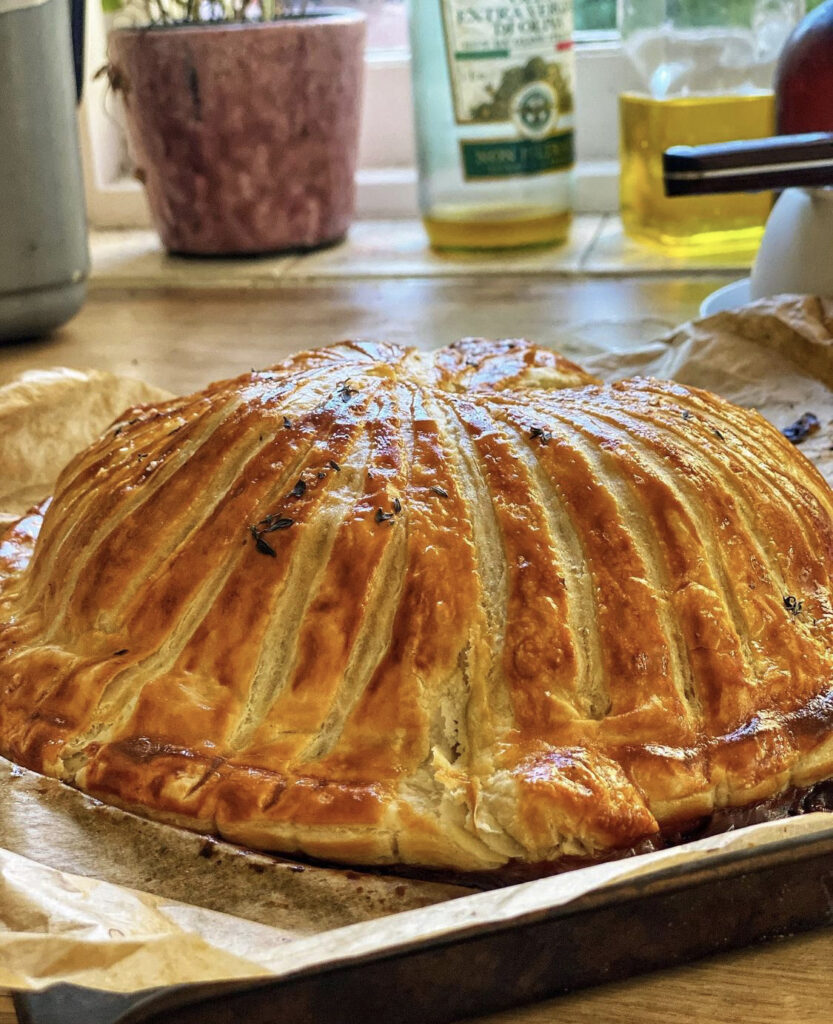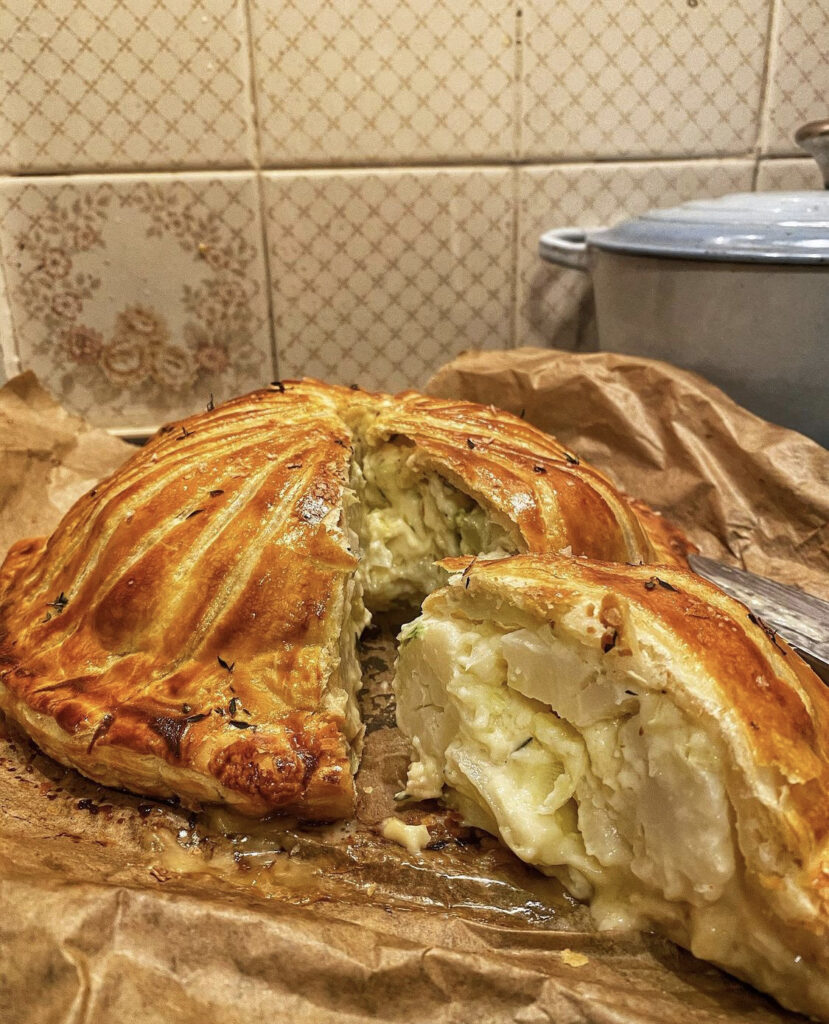
I wasn’t sure that cauliflower cheese could really be improved upon, but the idea of encasing it in golden layers of crispy, airy puff pastry with a smear of quince jelly, a slab of oozing brie and some chopped cornichons for crunch and acidity really caught my imagination – and it really works. In fact, it’s much lighter than it might look. This first appeared in the Sunday Times (along with some more make-ahead festive recipes that might come in handy this Christmas), and I know some of you made it then – I really loved seeing the pictures doing the rounds on Instagram – so keep on tagging if you do decide to make this. I think this pie could be a wonderful Christmas Day celebration for veggies, as it would be so good with roast potatoes and all the trimmings, but it’s also a nice one to prep in advance and bust out when you might need it. I’m including info on how to freeze it too, as it freezes really well after being baked. While this vegetable-led showstopper may look like an intimidating prospect, if you follow the steps below, and allow time for chilling at the crucial stages, you’ll be delighted by what you create. I prefer the blocks of all-butter shop-bought puff pastry to the sheets because they are much more forgiving.


Cauliflower Cheese Pithivier
Ingredients2 blocks of ready-made puff pastry700g cauliflower, broken into florets, leaves and stalks included and chopped40g unsalted butterLeaves from two sprigs of thyme, plus more for scattering1 leek, cleaned and finely sliced50g plain flour450ml whole milk100g mature cheddar, grated50g comté, gratedA grating of nutmegA pinch of cayenne pepper1 tbsp Dijon mustard1 tsp white wine vinegar, cider vinegar or lemon juice2 tbsp quince or cranberry jelly150g brie, sliced8 cornichons, sliced1 egg, beaten, for eggwashA pinch of sea salt
01 First prepare the pastry. Lightly flour a worktop and roll out the first block, rotating it by 90 degrees as you roll, into a large square, about 25cm across and ½cm thick. Repeat with the other block, rolling this one out into a larger square, 30cm across. Score around a dinner plate with a 25cm diameter and cut a 25cm circle out of the smaller square. With the larger piece of pastry, use the plate as a template again, but this time add 2½cm around the edge and cut out a 30cm circle. Lay the two circles on to baking paper and refrigerate them while you make the filling.02 To make the filling, first parboil your cauliflower in plenty of boiling salted water for 6 min, then drain it and leave it to sit and steam in the colander.03 To make the cheese sauce, melt the butter with the thyme leaves in a nonstick saucepan over a medium heat, then add the leek and season. Cook, stirring, for about 5 min, until the leek has softened but not coloured, then scatter over the flour and toss to coat the leek. Slowly pour in the milk, blending it in with a whisk, to form a thick roux, and then a sauce. Keep cooking, whisking out any lumps, for about 5-6 min, until the sauce has thickened and is smooth, then slide in the cheddar and comté and stir to melt. Taste and season with fresh nutmeg, cayenne, mustard and a teaspoon of vinegar or lemon juice.04 Put the cauliflower back in the pan you cooked it in and pour over the cheese sauce, stirring to combine, until it’s well coated. Line a bowl 18cm across and 7cm deep (smaller than your smaller pastry circle) with clingfilm and pour the cauliflower cheese into it, pressing the cauliflower down into the bowl. Cover it and refrigerate for at least an hour to set.05 Once the cauliflower mixture has set, bring out your pastry. Lay the smaller circle, the base, on its paper on a baking sheet and spread it with the quince or cranberry jelly, leaving a good 1.5-2cm around the edge, then top with the brie slices and then the cornichons. Unwrap the cauliflower, pull it out of the bowl using the clingfilm’s edges and invert it into the middle of the pastry in a neat mound. Peel off the clingfilm.06 Working fast, egg wash the edge of the pastry, top it with the larger circle of pastry and press the edges together all the way around to seal the pie firmly. I like to trim the edge of the pithivier at this point to neaten it up, then scallop the edge by pressing into the pastry at regular intervals using the back of a knife, all the way around. Brush the entire surface with the eggwash and refrigerate the pithivier for 30 min.07 Using a sharp knife, poke a hole in the centre of the top of the pithivier to let out steam, and score half-circle swirls out from there all the way round the pie’s top. Wash it with egg once more, and refrigerate it for another 15 min (or overnight) to set while you heat the oven to 160C (180C non-fan). Scatter over the thyme leaves and some sea salt, then bake in the oven for 35-40 min, until the pastry is beautifully puffed and golden. and it’s piping hot all the way through. Allow to settle for 15 min, then cut into slices to serve.How to freezeAllow the pithivier to cool completely after baking, then wrap it carefully and well in clingfilm. Find a space in your freezer that will accommodate it without squashing it. When you want to eat it, defrost thoroughly then cover with foil and heat through in an oven heated to 150C (170C non-fan) for 25 min or until piping hot.
